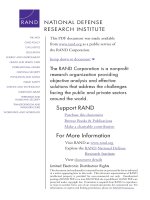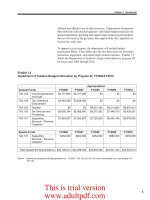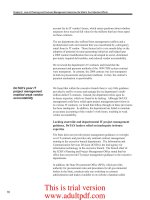Lecture Principle of inventory and material management - Lecture 5
Bạn đang xem bản rút gọn của tài liệu. Xem và tải ngay bản đầy đủ của tài liệu tại đây (465.38 KB, 37 trang )
Lecture 5
Master Product Scheduling
Books
•
Introduction to Materials Management, Sixth Edition, J. R. Tony Arnold, P.E., CFPIM, CIRM, Fleming
College, Emeritus, Stephen N. Chapman, Ph.D., CFPIM, North Carolina State University, Lloyd M.
Clive, P.E., CFPIM, Fleming College
•
Operations Management for Competitive Advantage, 11th Edition, by Chase, Jacobs, and Aquilano, 2005,
N.Y.: McGrawHill/Irwin.
Objectives
•
•
•
Master product scheduling
Round cut capacity planning
Planning horizons
Purpose
•
•
The master production schedule states the
requirements for individual end items by date and
quantity. It is limited by the production plan and must
“disaggregate” the production plan.
Master planning seeks to plan and control the impact
of independent demand on material and capacity.
Purpose
•
The master production schedule is a vital link between
sales and production
– It makes possible valid order promises
– It represents a contract between sales and
production.
Inputs
•
Inputs to the master production schedule include
– The production plan
– The forecast
– Orders from customers
– Additional independent demand
– Inventory levels
– Capacity constraints
Objectives
•
The objectives of a master production schedule are to
– Maintain the desired level of customer service
–
Make the best use of resources
–
Keep inventories at the desired level
Preparing an MPS
•
•
•
Make a preliminary MPS
Perform roughcut capacity planning
Resolve differences
Roughcut Capacity Planning
•
•
•
Roughcut capacity planning checks whether critical
resources are available to support the preliminary
master schedule.
A resource bill shows the time required for individual
items on a critical resource.
What are some possible critical resources?
Resolving Differences
•
•
The third step in developing an MPS is to resolve any
differences between the priority plan and available capacity.
Available capacity must be equal to or greater than required
capacity
If required capacity exceeds available capacity
–
Capacity must be increased
or
Plan must be altered
How can capacity be increased or demand be decreased?
–
•
Resolving Differences
•
The master production schedule must be judged by three
criteria
–
–
–
Resources use. Is the MPS within capacity restraints in
each period of the plan? Does it make the best use of
resources?
Customer service. Will due dates be met and will
delivery performances be acceptable?
Cost. Is the plan economical, or will excess cost be
incurred for overtime, subcontracting, expediting, or
transportation?
Production Scheduling and Sales
•
•
An MPS is not a sales forecast, it is instead a
forecast of production. It may not necessarily
be what we want; it should be what we can do.
The MPS must be realistic and achievable.
Otherwise, the plan fails, deliveries are not
met, and manufacturing has to react to
circumstances rather than planning for them.
MPS and Delivery Promises
Units
Production Capacity or Inventory
Available-toPromise
Customer
Orders
Time
•
•
As orders are received, they “consume” available
production and inventory
Any part not consumed is availabletopromise
AvailabletoPromise
•
AvailabletoPromise is
– the uncommitted portion of a company’s inventory
and planned production, maintained in the master
schedule to support customer order promising. The
ATP quantity is the uncommitted inventory balance
in the first period and is normally calculated for each
period in which an MPS receipt is scheduled
APICS Dictionary, 8th edition
AvailabletoPromise
•
The ATP calculation assumes that the entire ATP
will be sold before the next scheduled receipt.
When calculating ATP, consider all orders until
the next scheduled receipt.
ATP for period 1 = on hand customer orders due
before next MPS scheduled receipt
ATP for periods 2, 4, and 6 = MPS scheduled
receipt customer orders due before next MPS
scheduled receipt
AvailabletoPromise
On hand = 200 units
Period
Customer Orders
MPS Scheduled
Receipts
Available-toPromise
1
160
?
2
20
200
3
20
4
200
5
50
6
200
AvailabletoPromise
On hand = 200 units
Period
Customer Orders
MPS Scheduled
Receipts
Available-toPromise
1
160
40
2
20
200
3
20
4
200
5
50
6
200
AvailabletoPromise
On hand = 200 units
Period
Customer Orders
MPS Scheduled
Receipts
Available-toPromise
1
160
40
2
20
200
160
3
20
4
200
5
50
6
200
AvailabletoPromise
On hand = 200 units
Period
Customer Orders
MPS Scheduled
Receipts
Available-toPromise
1
160
40
2
20
200
160
3
20
4
5
50
6
200
200
150
200
Planning Horizon
The planning horizon is defined as
the amount of time the master schedule extends into the
future. This is normally set to cover a minimum of
cumulative lead time plus time for lot sizing low
level components and for capacity changes of
primary work centers or of key suppliers.
APICS Dictionary, 8th edition
Planning Horizon
B
Lead Time
= 6 weeks
A
Lead Time
= 2 weeks
C
Lead Time
= 5 weeks
What is the minimum planning
horizon in this example?
✦
D
Lead Time
= 8 weeks
E
Lead Time
= 16 weeks
Time Fences and Zones
0
2 weeks
26 weeks
Frozen
Slushy
Actual Orders
Actual and Forecast
(Emergency
Changes
Only)
(Trade-offs)
Due
Date
Demand
Time
Fence
Liquid
Forecast
Only
(Changes
constrained
by production
plan
Planning
Time
Fence
21
Master Production Scheduling (MPS)
Objectives of MPS
•
•
•
Determine the quantity and timing of completion of
end items over a shortrange planning horizon.
Schedule end items (finished goods and parts shipped
as end items) to be completed promptly and when
promised to the customer.
Avoid overloading or underloading the production
facility so that production capacity is efficiently
utilized and low production costs result.
Time Fences
●
The rules for scheduling
12
weeks
No Change
Frozen
24
weeks
46
weeks
6+
weeks
+/ 5%
+/ 10%
+/ 20%
Change
Change
Change
Firm
Full
Open
Time Fences
•
The rules for scheduling:
– Do not change orders in the frozen zone
– Do not exceed the agreed on percentage changes
when modifying orders in the other zones
– Try to level load as much as possible
– Do not exceed the capacity of the system when
promising orders.
– If an order must be pulled into level load, pull it
into the earliest possible week without missing the
promise.









